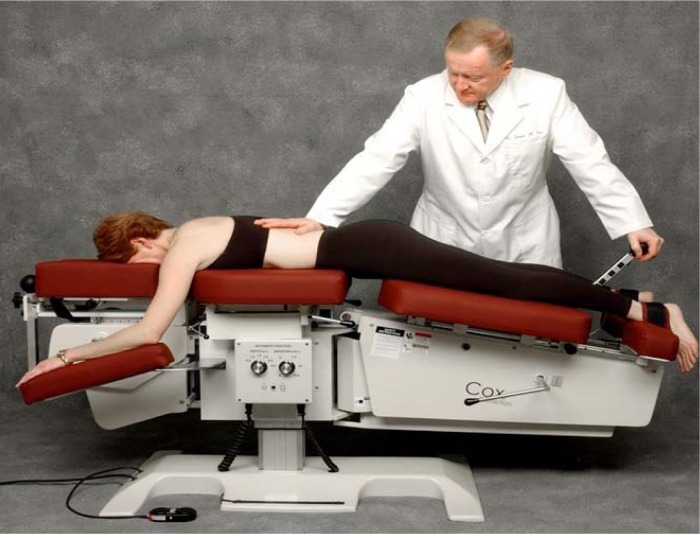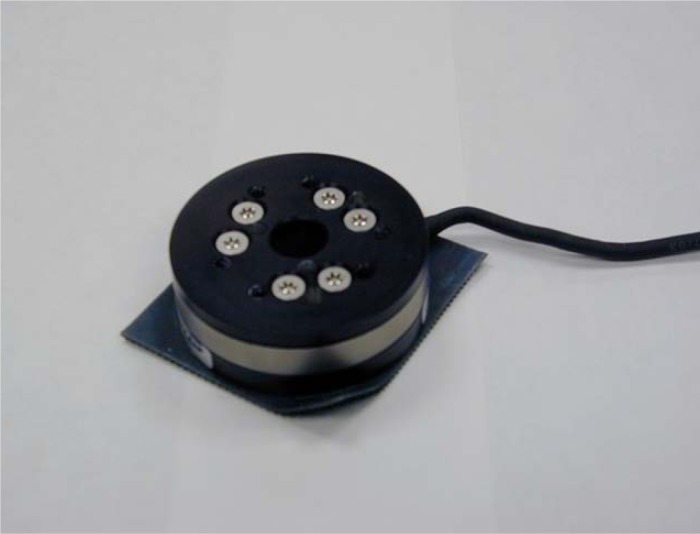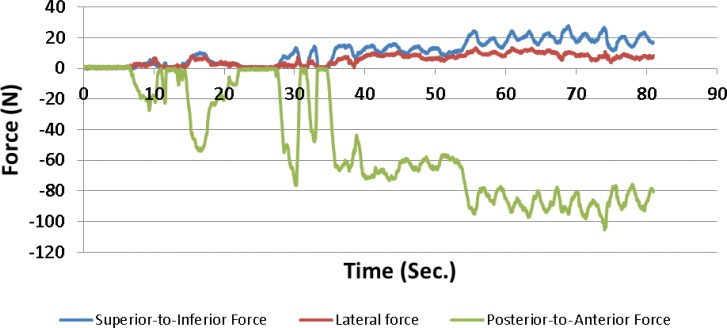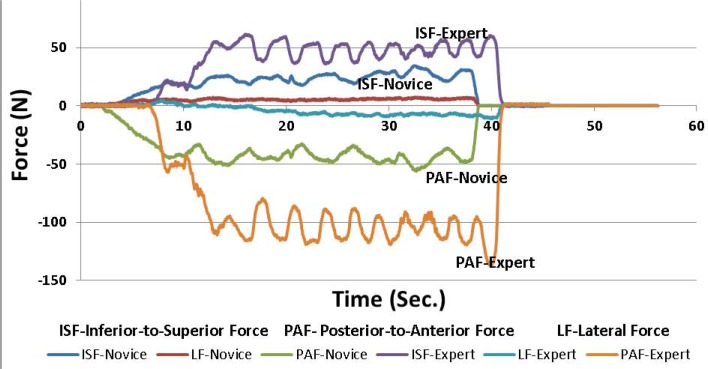Abstract
A form of chiropractic procedure known as Cox flexion-distraction is used by chiropractors to treat low back pain. Patient lies face down on a specially designed table having a stationery thoracic support and a moveable caudal support for the legs. The Doctor of Chiropractic (DC) holds a manual contact applying forces over the posterior lumbar spine and press down on the moving leg support to create traction effects in the lumbar spine. This paper reports on the development of real-time feedback on the applied forces during the application of the flexion-distraction procedure. In this pilot study we measured the forces applied by experienced DCs as well as novice DCs in using this procedure. After a brief training with real-time feedback novice DCs have improved on the magnitude of the applied forces. This real-time feedback technology is promising to do systematic studies in training DCs during the application of this procedure.
Keywords: Cox, flexion-distraction, technique, real-time, chiropractic
Abstract
Une forme de procédure chiropratique connue sous le nom de flexion-distraction Cox est employée par les chiropraticiens dans le traitement de la lombalgie. Le patient se couche sur le ventre sur une table spécialement conçue, qui comporte un support thoracique stationnaire et un support caudal mobile pour les jambes. Le docteur en chiropratique (DC) maintient un contact manuel en appliquant une force sur la colonne lombaire postérieure, et appuie sur le support mobile pour les jambes afin de créer un effet de traction dans la colonne lombaire. Le présent article se veut un rapport sur le développement d’une rétroaction en temps réel au sujet des forces appliquées au cours de l’utilisation de la procédure de flexion-distraction. Dans cette étude pilote, nous avons mesuré les forces appliquées par des DC ayant de l’expérience et des DC débutants pendant l’application de cette procédure. Après une brève formation avec rétroaction en temps réel, les DC débutants s’étaient améliorés relativement à la magnitude des forces appliquées. Cette technologie de rétroaction en temps réel est prometteuse pour la réalisation d’études systématiques sur la formation des DC durant l’application de cette procédure.
Keywords: Cox, flexion-distraction, technique, temps réel, chiropratique
Introduction
Musculoskeletal conditions are common causes of pain and disability with low back pain representing a prevalent complaint and costly societal burden.1–7 Doctors of chiropractic (DCs) treat low back pain patients to relieve discomfort and improve function. DCs may deliver several types of chiropractic adjustments or spinal manipulation therapy (SMT) to the spine for the treatment of musculoskeletal (MSK) conditions. SMT includes manual high velocity low amplitude spinal manipulative (HVLA-SM) procedures, handheld instrument assisted techniques, low-velocity distraction procedures, drop piece high-velocity techniques.8
Chiropractic students traditionally learn the technique of delivering SMT procedures by observing someone skilled in a procedure. The expert teacher demonstrates a technique and the student then practices its delivery on other students or volunteer patients. The teacher observes the student performing a manual procedure and provide hands-over-hands guidance, and provide verbal feedback as the student develops proficiency. Experienced DCs provide training in a similar manner with student interns in clinical situations. Triano et al. have reviewed on the training methods used in the literature.9
Chiropractic techniques are measurable biomechanical events involving the application of forces to specific regions of interest, causing vertebral movements.10–13 Several investigators have measured the forces delivered by DCs during manipulations of the lumbar, thoracic and cervical spine.14–20 HVLA-SM is characterized by clinical force delivery, loading durations, loading rates, coordination index, and transmitted loads to the spine.
Over the past decade, educators have incorporated innovative bioengineering technologies into the training of chiropractic students and licensed doctors to give feedback on the forces, durations, loading rates, and coordination indexes. Mechanical instruments, mannequins, and human volunteers were used for training. Subsequently, researchers have demonstrated quantified force-time profile characteristics.16,21–25 Most of these studies focused on HVLA-SM, with the majority evaluating the thoracic and lumbar spine.16;21–24 Few studies have measured the biomechanical characteristics of HVLA-SM delivery to the cervical spine24,25, and few studies on these parameters with mobilization procedures26–29.
James Cox, DC developed manual distraction, or the flexion distraction procedure, to treat patients with spinal problems.30,31 Several case reports, case series, and a randomized clinical trial have been published for treating neck and low back pain problems using this procedure.32–38 During Cox Flexion-Distraction procedure, the patient lies face down on a specially designed chiropractic table. The DC gently moves the caudal section of the table while holding a broad manual contact over the posterior part of the low back with a vertebral level selected, with an intent to create traction effects in the lumbar spine.
This paper reports on the development of real-time force feedback at the Palmer Center for Chiropractic Research, which provides clinicians with real time visual graphical feedback on the magnitude of forces at the contact hand of the DC on the participant’s lumbar spine. This novel training tool was used to collect pilot data while Cox Flexion-Distraction was applied to simulated asymptomatic volunteers by experienced DCs as well as novice DCs.
Methods
The Palmer College of Chiropractic (PCC) institutional review board approved this study. Human simulated patient volunteers and the doctors of chiropractic volunteers signed written informed consent to participate in the study.
Recruitment
Four asymptomatic volunteers (2 male and 2 female age range 22–52 years old) served as simulated patients, recruited from the doctors attending a Cox certification course. DCs screened volunteers for any contraindications and safety considerations relative to receiving the Cox flexion-distraction procedure before study inclusion. Five experienced (>15 years experience in using flexion distraction procedure) DCs and 5 Novice DCs (<1 year experience in using flexion-distraction procedure) participated in the measurement of force delivery.
Force Transducer and Force Feedback Software
During the Cox Flexion-distraction procedure the DC contacts the posterior aspect of the lumbar spine using one hand and applies downward motion of the caudal section of the table where the ankles are cuffed to the table. DCs apply posterior-to-anterior forces (PAF) as well as inferior-to-superior forces (ISF) at the stabilizing hand contact on the posterior aspect of the lumbar spine. Figure 1 shows the table, the patient in a prone position, and the hand contacts. A three dimensional force transducer (Model # Mini-45, ATI-Industrial Automation, Apex, NC) was used to measure the three dimensional forces applied by the DC at the lumbar spine contact. Figure 2 shows the force transducer and the negative Fz axis is directed in the posterior-to-anterior direction of the patient, positive Fx axis is directed along the inferior-to-superior-direction of the volunteer participant. A rubber padding is placed between the patient and the transducer. The measurement of forces is achieved with the help of a three-dimensional force transducer, amplifiers, analog-to-digital converters, laptop portable computer, and custom written Labview software. A custom written software provides the graphical visual feedback in real time as a function of time during the delivery of the treatment. Figure 3 shows force-time graph with the possibility to change the applied force while delivering the treatment (visual real-time graphical feedback). The software was written in Labview (Version 7, National Instruments, Austin, TX). The data is collected at a sampling rate of 100Hz. Magnitude of forces in the inferior-to-superior direction and posterior-to-anterior direction at the hand contact can be simultaneously incorporated into the training.
Figure 1.
Cox Flexion-Distraction Table with hand contacts for treating low back.
Figure 2.
Three Dimensional Force Transducer used in the study along with rubber padding.
Figure 3.
A typical Force time graph displayed by the computer and the clinician’s ability to alter the forces
We have independently tested the force transducer measures (Model: Mini45, ATI industrial Automation, Apex, NC) against a 3-D force plate (Model 4060NC, Bertec Corporation, Columxbus, OH) (20) in both normal and shear directions and found good agreement (less than 3% difference). During Cox flexion-distraction procedure for treating low back, forces are delivered in a gentle slow manner at a rate of approximately 0.5 Hz. Cox flexion distraction for low back pain is a form of low velocity variable amplitude spinal manipulation (LVVA SM). The procedure is performed with a participant lying prone on a specially designed table with a fixed section of the table under the trunk, and a moveable caudal section that allows guided flexion and traction movement in the lumbar spine. The clinician gently grasps the posterior aspect of the participant’s back with a thenar contact (contact hand) at a specific vertebral level. With the opposite hand, the clinician grasps the control handle of the moving piece near the ankles. Using the contact hand, the clinician exhibits traction while attempting to maintain a contact at a single vertebral level and ensuring a gentle movement of the caudal section via contact with the control handle. The goal is to create a slow rhythmic distractive movement.
Figure 1 shows a manual contact used by DCs while performing the low back pain procedure. Because low back stiffness and lumbar spine anatomy differ between patients, force-feedback training provides clinicians an opportunity to perceive and gauge force magnitudes on different body types.
We have collected the data from five experienced clinicians with 15, 17, 21, 26, and 35 years experience in using the flexion-distraction technique and five novice clinicians (less than one year experience) in using this technique. Novice clinicians were given a brief training approximately 5 minutes while practicing using this force transducer and the real-time visual graphical feedback. After brief training we measured the forces of the five novice clinicians while delivering on asymptomatic volunteers.
The data is exported into an excel file and then to a custom written MathCad software program (version12, Parametric Technologies, Natick, MA). The magnitudes of forces corresponding to the preload and peak force are extracted and averaged for each doctor over five cycles. The averages for the experienced and the novice doctors are averaged and compared descriptively.
Results
Participants who received the lumbar Cox flexion-distraction procedure consisted of 2 males and 2 females (total of 4 participants). The mean age was 45 years old (SD: 12). The mean height of participants was 172.8cm (SD: 7.7cm) and mean weight was 79.6kg (SD: 22.0kg).
Five experienced field clinician DCs (2 males and 3 females) with a wide range of clinical experience (15-35 years experience using flexion-distraction procedure) performed the lumbar flexion-distraction on all the four participants. This provided a reference data for comparison. Five recently graduated DCs with less than one year experience using flexion-distraction procedure (3 male and 2 female) participated in training. Figure 4 shows the graphical data on the forces used by a typical experienced DC as well as a novice DC. Table 1 provides the forces comparing the experienced and novice doctors. Table 2 provides the data on the novice doctors before and after a brief training using the software developed for training.
Figure 4.
A typical force time graph of experienced and novice Doctors of Chiropractic
Table 1.
Descriptive values of Forces by experienced and novice Doctors of Chiropractic
| Variable | Novice DCs (N=5) Mean (SD) | Experienced DCs (N=5) Mean (SD) |
|---|---|---|
| Inferior-to-Superior Forces | ||
| Pre-load (N) | 19 (6) | 44 (16) |
| Peak Force (N) | 41 (12) | 65 (10) |
| Posterior-to-Anterior Forces | ||
| Pre-load (N) | 46 (27) | 95 (34) |
| Peak Force (N) | 86 (45) | 140 (43) |
N-Newtons
Table 2.
Descriptive comparison of forces of novice Doctors of Chiropractic before and after training
| Variable | Before Training (N=5) Mean (SD) | After Training (N=5) Mean (SD) |
|---|---|---|
| Inferior-to-Superior Forces | ||
| Pre-load (N) | 19 (6) | 31 (12) |
| Peak Force (N) | 41 (12) | 52 (12) |
| Posterior-to-Anterior Forces | ||
| Pre-load (N) | 46 (27) | 69 (30) |
| Peak Force (N) | 86 (45) | 102 (43) |
N-Newtons
Discussion
To the best of these authors’ knowledge, this is the first investigation in developing real-time force feedback and visual graphical display to deliver Cox flexion-distraction for lumbar spine. This real-time force feedback provides a foundation to monitor clinician force delivery and train clinicians to alter the delivery of force ranges. This real-time force feedback developed in this study is portable and could be easily implemented in classrooms, teaching clinics, and field settings.
This is a pilot study in collecting data on experienced and novice DCs using flexion-distraction procedure. Forces applied by experienced DCs are higher compared to the novice DCs. After a brief training of 5 minutes the force magnitudes have improved in preload as well as peak forces for the novice doctors. This improvement was observed for both posterior-to-anterior forces as well as inferior-to-superior forces.
Traditional approaches to technique training for Coxflexion distraction have included observation and feed-back by an instructor/mentor. This method is based primarily on the subjective evaluation of distraction technique as a complex psychomotor skill rather than measuring the biomechanical event. The real-time visual graphical feedback of forces developed in this project extends this subjective evaluation process by providing real-time quantitative force data. As seen in Figure 3 one can notice the improvement of the application of forces during training. Initially the novice DC was applying light forces with no pre-load, gradually improving on the magnitude of the pre-load as well as peak forces by using the real-time visual graphical feedback on the computer monitor. This allows clinicians and students the opportunity to hone in their ability to deliver specific biomechanical forces. Peer and participant feedback/debriefing, delivered verbally, remained an essential component of clinician training.
Other investigators have used training instruments and instrumented mannequins to obtain visual feedback on forces and force-time profiles16–22 during HVLA-SM, comparing force-time characteristics of students and clinicians. Our study is different from these studies in two ways: a) our study is based on real time graphical feedback while delivering treatment on human volunteers and b) for delivering a low velocity procedure such as flexion distraction and the DC can vary the treatment forces during the delivery with visual graphical feedback similar to the study reported on posterior to anterior mobilization forces on cervical spine29.
Manual therapists apply forces to the spine for several reasons including improving joint mobility, reducing muscular hypertonicity, stimulating proprioceptive activity, and to relieve pain.26 Force-magnitude related therapeutic effects have not been studied, but this technology will also allow to train clinicians to deliver treatment within specified force values. Applying treatment within specific force ranges can be a first step toward developing clinical studies designed to investigate optimum force-dosage in clinical settings. This will also allow clinical/physiological outcomes evaluation of patients as a function of different force ranges as an intervention.
Limitations
This study with a small sample size is not designed to test the differences between experienced DCs and novice DCs. Neither the study is designed to test the training process using a control group. This study is designed to provide real-time visual graphical feedback. This real-time force feedback could be used to design and conduct control studies to evaluate training and proficiency of novice DCs, and chiropractic students. The improvement in the delivery of the forces could be related to immediate learning effect. Considering this possibility, future studies should be undertaken to quantify the retention of this training procedure.
Conclusions
Real-time visual graphical feedback was developed and used to train novice DCs to change the force magnitudes applied during flexion-distraction procedure. This technology has the potential to design and undertake well designed studies in training and assessing the delivery of forces during flexion-distraction procedure. The system developed in this study is portable with a laptop computer and can be easily implemented in any field clinician’s office.
Acknowledgements:
This investigation was conducted in a facility constructed with support from research facilities improvement program grant # C06 RR15443-01 from the National Center for Research Resources, National Institutes of Health. The authors also acknowledge the donations received from practicing Doctors of Chiropractic.
References
- 1.Murray CJ, Vos T, Lozano R, Naghavi M, Flaxman AD, Michaud C, et al. Disability-adjusted life years (DALYs) for 291 diseases and injuries in 21 regions, 1990–2010: a systematic analysis for the Global Burden of Disease Study 2010. Lancet. 2012 Dec 15;380(9859):2197–223. doi: 10.1016/S0140-6736(12)61689-4. [DOI] [PubMed] [Google Scholar]
- 2.Vos T, Flaxman AD, Naghavi M, Lozano R, Michaud C, Ezzati M, et al. Years lived with disability (YLDs) for 1160 sequelae of 289 diseases and injuries 1990–2010: a systematic analysis for the Global Burden of Disease Study 2010. Lancet. 2012 Dec 15;380(9859):2163–96. doi: 10.1016/S0140-6736(12)61729-2. [DOI] [PMC free article] [PubMed] [Google Scholar]
- 3.Buchbinder R, Blyth FM, March LM, Brooks P, Woolf AD, Hoy DG. Placing the global burden of low back pain in context. Best Pract Res Clin Rheumatol. 2013 Oct;27(5):575–89. doi: 10.1016/j.berh.2013.10.007. [DOI] [PubMed] [Google Scholar]
- 4.Deyo RA, Ching A. Surgical trials for pain relief: in search of better answers. Pain. 2012 Nov;153(11):2155–6. doi: 10.1016/j.pain.2012.07.017. [DOI] [PubMed] [Google Scholar]
- 5.Hayden JA, Dunn KM, van der Windt DA, Shaw WS. What is the prognosis of back pain? Best Pract Res Clin Rheumatol. 2010 Apr;24(2):167–79. doi: 10.1016/j.berh.2009.12.005. [DOI] [PubMed] [Google Scholar]
- 6.Hayden JA, Chou R, Hogg-Johnson S, Bombardier C. Systematic reviews of low back pain prognosis had variable methods and results: guidance for future prognosis reviews. J Clin Epidemiol. 2009 Aug;62(8):781–96. doi: 10.1016/j.jclinepi.2008.09.004. [DOI] [PubMed] [Google Scholar]
- 7.Tiira AH, Paananen MV, Taimela SP, Zitting PJ, Jarvelin MR, Karppinen JI. Determinants of adolescent health care use for low back pain. Eur J Pain. 2012 Nov;16(10):1467–76. doi: 10.1002/j.1532-2149.2012.00178.x. [DOI] [PubMed] [Google Scholar]
- 8.Christensen MG, Mark G, Kollash MW, Hyland JK. Practice Analysis of Chiropractic 2010: A project report, survey analysis, and summary of chiropractic practice in the United States. Greeley, Colorado: National Board of Chiropractic Examiners; 2010. [Google Scholar]
- 9.Triano JJ, Descarreaux M, Dugas C. Biomechanics – review of approaches for performance training in spinal manipulation. J Electromyogr Kinesiol. 2012 Oct;22(5):732–9. doi: 10.1016/j.jelekin.2012.03.011. [DOI] [PubMed] [Google Scholar]
- 10.Hessell BW, Herzog W, Conway PJ, McEwen MC. Experimental measurement of the force exerted during spinal manipulation using the Thompson technique. J Manipulative Physiol Ther. 1990 Oct;13(8):448–53. [PubMed] [Google Scholar]
- 11.Forand D, Drover J, Suleman Z, Symons B, Herzog W. The forces applied by female and male chiropractors during thoracic spinal manipulation. J Manipulative Physiol Ther. 2004 Jan;27(1):49–56. doi: 10.1016/j.jmpt.2003.11.006. [DOI] [PubMed] [Google Scholar]
- 12.Herzog W, Conway PJ, Kawchuk GN, Zhang Y, Hasler EM. Forces exerted during spinal manipulative therapy. Spine (Phila Pa 1976) 1993 Jul;18(9):1206–12. doi: 10.1097/00007632-199307000-00014. [DOI] [PubMed] [Google Scholar]
- 13.Herzog W, Kats M, Symons B. The effective forces transmitted by high-speed, low-amplitude thoracic manipulation. Spine (Phila Pa 1976) 2001 Oct 1;26(19):2105–10. doi: 10.1097/00007632-200110010-00012. [DOI] [PubMed] [Google Scholar]
- 14.Herzog W, Zhang YT, Conway PJ, Kawchuk GN. Cavitation sounds during spinal manipulative treatments. J Manipulative Physiol Ther. 1993 Oct;16(8):523–6. [PubMed] [Google Scholar]
- 15.Symons B, Wuest S, Leonard T, Herzog W. Biomechanical characterization of cervical spinal manipulation in living subjects and cadavers. J Electromyogr Kinesiol. 2012 Mar 6; doi: 10.1016/j.jelekin.2012.02.004. [DOI] [PubMed] [Google Scholar]
- 16.Cohen E, Triano JJ, McGregor M, Papakyriakou M. Biomechanical performance of spinal manipulation therapy by newly trained vs. practicing providers: does experience transfer to unfamiliar procedures? J Manipulative Physiol Ther. 1995 Jul;18(6):347–52. [PubMed] [Google Scholar]
- 17.Triano J, Schultz AB. Loads transmitted during lumbosacral spinal manipulative therapy. Spine (Phila Pa 1976) 1997 Sep 1;22(17):1955–64. doi: 10.1097/00007632-199709010-00003. [DOI] [PubMed] [Google Scholar]
- 18.Stemper BD, Hallman JJ, Peterson BM. An experimental study of chest compression during chiropractic manipulation of the thoracic spine using an anthropomorphic test device. J Manipulative Physiol Ther. 2011 Jun;34(5):290–6. doi: 10.1016/j.jmpt.2011.04.001. [DOI] [PubMed] [Google Scholar]
- 19.Descarreaux M, Dugas C. Learning spinal manipulation skills: assessment of biomechanical parameters in a 5-year longitudinal study. J Manipulative Physiol Ther. 2010 Mar;33(3):226–30. doi: 10.1016/j.jmpt.2010.01.011. [DOI] [PubMed] [Google Scholar]
- 20.Gudavalli MR, DeVocht J, Tayh A, Xia T. Effect of sampling rates on the quantification of forces, durations, and rates of loading of simulated side posture high-velocity, low-amplitude lumbar spine manipulation. J Manipulative Physiol Ther. 2013 Jun;36(5):261–6. doi: 10.1016/j.jmpt.2013.05.010. [DOI] [PMC free article] [PubMed] [Google Scholar]
- 21.Descarreaux M, Dugas C, Lalanne K, Vincelette M, Normand MC. Learning spinal manipulation: the importance of augmented feedback relating to various kinetic parameters. Spine J. 2006 Mar;6(2):138–45. doi: 10.1016/j.spinee.2005.07.001. [DOI] [PubMed] [Google Scholar]
- 22.Descarreaux M, Dugas C, Raymond J, Normand MC. Kinetic analysis of expertise in spinal manipulative therapy using an instrumented manikin. J Chiropr Med. 2005;4(2):53–60. doi: 10.1016/S0899-3467(07)60114-1. [DOI] [PMC free article] [PubMed] [Google Scholar]
- 23.Triano JJ, Rogers CM, Combs S, Potts D, Sorrels K. Developing skilled performance of lumbar spine manipulation. J Manipulative Physiol Ther. 2002 Jul;25(6):353–61. doi: 10.1067/mmt.2002.126132. [DOI] [PubMed] [Google Scholar]
- 24.Triano JJ, Rogers CM, Combs S, Potts D, Sorrels K. Quantitative feedback versus standard training for cervical and thoracic manipulation. J Manipulative Physiol Ther. 2003 Mar;26(3):131–8. doi: 10.1016/S0161-4754(02)54105-1. [DOI] [PubMed] [Google Scholar]
- 25.Young TJ, Hayek R, Philipson SA. A cervical manikin procedure for chiropractic skills development. J Manipulative Physiol Ther. 1998 May;21(4):241–5. [PubMed] [Google Scholar]
- 26.Chiradejnant A, Latimer J, Maher CG. Forces applied during manual therapy to patients with low back pain. J Manipulative Physiol Ther. 2002 Jul;25(6):362–9. doi: 10.1067/mmt.2002.126131. [DOI] [PubMed] [Google Scholar]
- 27.Sheaves EG, Snodgrass SJ, Rivett DA. Learning lumbar spine mobilization: the effects of frequency and self-control of feedback. J Orthop Sports Phys Ther. 2012 Feb;42(2):114–24. doi: 10.2519/jospt.2012.3691. [DOI] [PubMed] [Google Scholar]
- 28.Snodgrass SJ, Rivett DA, Robertson VJ, Stojanovski E. Cervical spine mobilisation forces applied by physiotherapy students. Physiotherapy. 2010 Jun;96(2):120–9. doi: 10.1016/j.physio.2009.08.008. [DOI] [PubMed] [Google Scholar]
- 29.Snodgrass SJ, Rivett DA, Robertson VJ, Stojanovski E. Real-time feedback improves accuracy of manually applied forces during cervical spine mobilisation. Man Ther. 2010 Feb;15(1):19–25. doi: 10.1016/j.math.2009.05.011. [DOI] [PubMed] [Google Scholar]
- 30.Cox JM. Low back pain: Mechanism, diagnosis and treatment. Baltimore: Williams and Wilkins; 2011. [Google Scholar]
- 31.Cox JM. Neck, Shoulder, Arm Pain: Mechanism, Diagnosis, Treatment. (3rd Edition. 3rd ed) 2004 [Google Scholar]
- 32.Cox JM, Aspegren DD. Degenerative spondylolisthesis of C7 and L4 in same patient. J Manipulative Physiol Ther. 1988 Jun;11(3):195–205. [PubMed] [Google Scholar]
- 33.Gudavalli S, Kruse RA. Foraminal stenosis with radiculopathy from a cervical disc herniation in a 33-year-old man treated with flexion distraction decompression manipulation. J Manipulative Physiol Ther. 2008 Jun;31(5):376–80. doi: 10.1016/j.jmpt.2008.04.002. [DOI] [PubMed] [Google Scholar]
- 34.Kruse RA, Cambron JA. Large C4/5 spondylotic disc bulge resulting in spinal stenosis and myelomalacia in a Klippel-Feil patient. J Altern Complement Med. 2012 Jan;18(1):96–9. doi: 10.1089/acm.2010.0844. [DOI] [PubMed] [Google Scholar]
- 35.Kruse RA, Cambron J. Chiropractic management of postsurgical lumbar spine pain: a retrospective study of 32 cases. J Manipulative Physiol Ther. 2011 Jul;34(6):408–12. doi: 10.1016/j.jmpt.2011.05.011. [DOI] [PubMed] [Google Scholar]
- 36.Kruse RA, Imbarlina F, De Bono VF. Treatment of cervical radiculopathy with flexion distraction. J Manipulative Physiol Ther. 2001 Mar;24(3):206–9. [PubMed] [Google Scholar]
- 37.Cambron JA, Gudavalli MR, Hedeker D, McGregor M, Jedlicka J, Keenum M, et al. One-year follow-up of a randomized clinical trial comparing flexion distraction with an exercise program for chronic low-back pain. J Altern Complemen Med. 2006 Sep 1;12(7):659–68. doi: 10.1089/acm.2006.12.659. [DOI] [PubMed] [Google Scholar]
- 38.Gudavalli MR, Cambron JA, McGregor M, Jedlicka J, Keenum M, Ghanayem AJ, et al. A randomized clinical trial and subgroup analysis to compare flexion-distraction with active exercise for chronic low back pain. Eur Spine J. 2006 Jul;15(7):1070–82. doi: 10.1007/s00586-005-0021-8. [DOI] [PMC free article] [PubMed] [Google Scholar]






